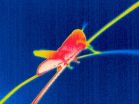(Press-News.org) DURHAM, N.C. -- If unwed parents are going to get married, the best window of opportunity for that union seems to be before their child turns 3, says a new study from Duke University.
But patterns vary greatly by race, with more African-American mothers marrying much later than mothers of other races or ethnicities.
Federal policies have often presumed that unmarried parents will be most receptive to marriage right after a baby's birth, a period that has been dubbed the "magic moment." The new study is the first to test that assumption, said author Christina Gibson-Davis.
"It turns out the 'magic moment' lasts longer than conventional wisdom has held," said Gibson-Davis, who teaches sociology at Duke's Sanford School of Public Policy and is a faculty fellow of the Duke Center for Child and Family Policy. "And for some subgroups, that moment lasts even longer."
Among African-American mothers, most marriages occurred after the child turned 3, says the study, which appears online July 2 in Demography.
The study also found that most children born out of wedlock don't remain so: 64 percent of children born out of wedlock see their moms get married, Gibson-Davis said. Many of those marriages don't last, however. Nearly half of post-conception marriages end in divorce, and those numbers are higher still for African-American women.
"These marriages are fragile," Gibson-Davis said. "If you think that stable marriage is beneficial for kids, very few kids born out of wedlock are experiencing that."
The odds improve somewhat when mothers marry their child's biological father, Gibson-Davis said. After 10 years, 38 percent of post-conception marriages involving biological parents had dissolved. In the same period of time, 54 percent of marriages to a stepfather had ended. Those findings held true across racial lines.
The study draws upon a nationally representative survey that looks at 5,255 U.S. children born out of wedlock.
Despite years of public attention to children born out of wedlock, big gaps remain in our picture of how these children actually live, Gibson-Davis said.
"Those who would promote marriage have more work to do," Gibson-Davis said.
INFORMATION:
CITATION: "Magic Moment? Maternal Marriage in Children Born out of Wedlock," Christina Gibson-Davis. Demography, July 2, 2014. DOI: 10.1007/s13524-014-0308-7
A 'magic moment' for unwed parents
Marriage between unwed parents more likely when child is young, but bonds are fragile
2014-07-02
ELSE PRESS RELEASES FROM THIS DATE:
How do ants get around? Ultra-sensitive machines measure their every step…
2014-07-02
How do ants manage to move so nimbly whilst coordinating three pairs of legs and a behind that weighs up to 60% of their body mass? German scientists have recently developed a device that may reveal the answer.
Measuring the forces generated by single limbs is vital to understanding the energetics of animal locomotion. However, with very small animals such as insects, this becomes problematic. Dr Reinhardt (Friedrich-Schiller University) used an elastic polycarbonate material to produce a miniature force plate. Springs arranged at right angles to each other enabled forces ...
Locusts harness the sun to get their optimum diet
2014-07-02
If you are a locust, the most nutritious plant to eat depends on the ambient temperature. Scientists at the University of Sydney, Australia, have discovered that locusts choose their food and then where they digest it according to how hot it is.
Dr Fiona Clissold, who led the study, explains why temperature has such a large influence on insect diets. "Whilst an insect's metabolic rate increases exponentially with temperature, the rate at which locusts absorb protein and carbohydrate from different plants does not increase in step with temperature. As a result, nutrient ...
Smarter than you think: Fish can remember where they were fed 12 days later
2014-07-02
It is popularly believed that fish have a memory span of only 30 seconds. Canadian scientists, however, have demonstrated that this is far from true – in fact, fish can remember context and associations up to twelve days later.
The researchers studied African Cichlids (Labidochromis caeruleus), a popular aquarium species. These fish demonstrate many complex behaviours, including aggression, causing the scientists to predict that they could be capable of advanced memory tasks. Each fish was trained to enter a particular zone of the aquarium to receive a food reward, with ...
A sheep's early life experiences can shape behavior in later life
2014-07-02
New research has found that a sheep's experiences soon after birth can shape its later behaviour and also that of its offspring.
The study led by academics from the University of Bristol's School of Veterinary Sciences and published in the Royal Society journal Biology Letters investigated whether early-life experiences can alter behavioural responses to a naturally painful event in adulthood – giving birth – and also affect behaviour of the next generation.
The period following birth can be a challenging time for young lambs. They are usually tail-docked without analgesia ...
Patients with severe ME have little or no access to specialist treatment services
2014-07-02
One in three severely affected adults with ME in England have no access to local specialist services, new research has shown.
Published in the British Medical Journal Open, the research by the University of Southampton reveals NICE guidelines, which say severely affected patients with ME, otherwise known as chronic fatigue syndrome (CFS), should have access to specialist care, are not being met by many NHS Trusts across England.
Over a third of specialist adult ME/CFS services in the NHS provide no service to severely affected patients, and a further 12 per cent of ...
Nature of solids and liquids explored through new pitch drop experiment
2014-07-02
VIDEO:
The movie clip shows the bitumen flow from the top camera view, and corresponds to approximately 24 days of real time.
Click here for more information.
Physicists at Queen Mary University of London have set up a new pitch drop experiment for students to explore the difference between solid and liquids.
Known as the 'world's longest experiment', the set up at the University of Queensland was famous for taking ten years for a drop of pitch – a thick, black, sticky ...
New study involving CU-Boulder tells the tale of a kangaroo's tail
2014-07-02
VIDEO:
This video is an analysis of video of kangaroos walking has helped scientists discover how important their tails are during locomotion.
Click here for more information.
Kangaroos may be nature's best hoppers. But when they are grazing on all fours, which is most of the time, their tail becomes a powerful fifth leg, says a new study.
Involving researchers at the University of Colorado Boulder, Simon Fraser University in Burnaby, Canada, and the University of New ...
The Lancet: Nearly 80 percent of US deaths in the first three decades of life are due to unintentional injury or violence
2014-07-02
A new report on unintentional injury and violence in the United States, published in The Lancet as part of a new Series, The health of Americans [1], has found that prevention strategies across society show a great deal of promise in preventing unintended deaths and injuries.
According to the report, by CDC researchers from Atlanta, USA, more Americans between the ages of one and 30 die from injury than from any other cause. Every year, nearly 180 000 people in the USA die from preventable causes such as automobile crashes, drowning, firearm-related injuries, falls, ...
The Lancet: Infectious diseases cause significant burden in the USA
2014-07-02
Infectious diseases remain major public health challenges in the United States, according to a new report published in The Lancet as part of a new Series, The health of Americans [1]. Endemic conditions such as chronic viral hepatitis, human immunodeficiency virus, and other sexually transmitted infections continue to affect millions of individuals, with racial and ethnic minorities disproportionately affected. Emerging and re-emerging vector borne and zoonotic disease infections are threatening new areas and populations, as most recently observed with Chikungunya. Despite ...
The Lancet: Chronic disease prevention one of 21st century's key challenges
2014-07-02
According to a report on chronic diseases by Centers for Disease Control and Prevention researchers, published in The Lancet as part of a new Series, The health of Americans [1], half of all adults in the USA suffer from at least one chronic condition, such as diabetes, heart disease, or obesity, and over a quarter of adults have two or more. The majority of these chronic conditions stem from a small number of risk factors that are largely preventable, including tobacco use, poor diet, and physical inactivity (both strongly associated with obesity), alcohol consumption, ...
LAST 30 PRESS RELEASES:
University of Oklahoma researcher awarded funding to pursue AI-powered material design
Exploring how the visual system recovers following injury
Support for parents with infants at pediatric check-ups leads to better reading and math skills in elementary school
Kids’ behavioral health is a growing share of family health costs
Day & night: Cancer disrupts the brain’s natural rhythm
COVID-19 vaccination significantly reduces risk to pregnant women and baby
The role of vaccination in maternal and perinatal outcomes associated with COVID-19 in pregnancy
Mayo Clinic smartwatch system helps parents shorten and defuse children's severe tantrums early
Behavioral health spending spikes to 40% of all children’s health expenditures, nearly doubling in a decade
Digital cognitive behavioral treatment for generalized anxiety disorder
Expenditures for pediatric behavioral health care over time and estimated family financial burden
Air conditioning in nursing homes and mortality during extreme heat
The Alps to lose a record number of glaciers in the next decade
What makes a good proton conductor?
New science reporting guide published for journalists in Bulgaria
New international study reveals major survival gaps among children with cancer
New science reporting guide published for journalists in Turkey
Scientists develop a smarter mRNA therapy that knows which cells to target
Neuroanatomy-informed brain–machine hybrid intelligence for robust acoustic target detection
Eight SwRI hydrogen projects funded by ENERGYWERX
The Lundquist Institute and its start-up company Vitalex Biosciences Announces Strategic Advancement of Second-Generation fungal Vaccine VXV-01 through Phase 1 Trials under $40 Million Competitive Con
Fine particles in pollution are associated with early signs of autoimmune disease
Review article | Towards a Global Ground-Based Earth Observatory (GGBEO): Leveraging existing systems and networks
Penn and UMich create world’s smallest programmable, autonomous robots
Cleveland researchers launch first major study to address ‘hidden performance killer’ in athletes
To connect across politics, try saying what you oppose
Modulating key interaction prevents virus from entering cells
Project explores barriers to NHS career progression facing international medical graduates
Jeonbuk National University researchers explore the impact of different seasonings on the flavor perception of Doenjang soup
Two Keck Medicine of USC Hospitals named Leapfrog Top Teaching Hospitals
[Press-News.org] A 'magic moment' for unwed parentsMarriage between unwed parents more likely when child is young, but bonds are fragile



